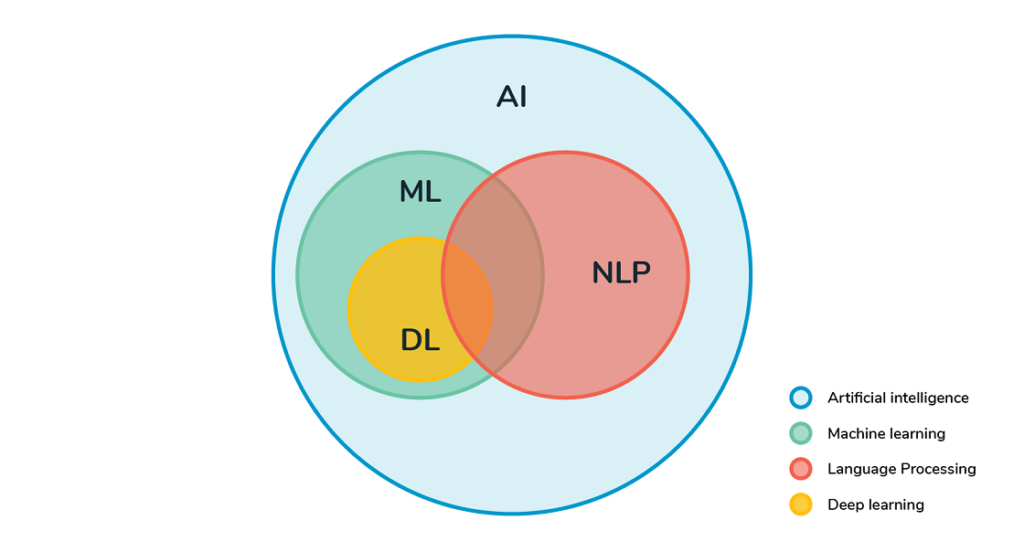Difference between Deep Learning and Natural Language Processing?
 Naveen
Naveen- 0

In the realm of artificial intelligence, two prominent domains, Deep Learning (DL) and Natural Language Processing (NLP), have emerged as powerful tools. While both are related to machine learning, they serve distinct purposes and possess unique characteristics. This article aims to delve into the dissimilarities between Deep Learning and Natural Language Processing, shedding light on their respective functionalities and applications.
Deep Learning: Unleashing the Potential of Neural Networks
Deep learning, a subset of machine learning, harnesses the capabilities of neural networks to model intricate functions. These networks comprise interconnected layers of artificial neurons that simulate the neural structure of the human brain. Through a process known as training, deep learning algorithms acquire the ability to recognize patterns and extract meaningful insights from vast amounts of data.
1.1 The Power of Deep Learning
Deep learning has brought about revolutionary advancements in various domains, including computer vision, speech recognition, and natural language understanding. Its capacity to autonomously learn hierarchical representations and make accurate predictions has propelled progress in image classification, object detection, and even autonomous driving.
1.2 Applications of Deep Learning
Deep learning finds application in numerous sectors, such as:
Medical Diagnosis: Deep learning algorithms can analyze medical images and assist in diagnosing diseases like cancer, Alzheimer’s, and cardiovascular disorders with remarkable accuracy.
Natural Language Processing:
Deep learning models excel in language-related tasks, including sentiment analysis, machine translation, and text generation.
Recommendation Systems:
Personalized recommendations in e-commerce platforms and streaming services rely on deep learning to understand user preferences and provide tailored suggestions.
Natural Language Processing: Decoding Human Language
Natural Language Processing (NLP) is a field that empowers computers to understand and interact with human language. It involves the application of computational algorithms to process and analyze text or speech data. By converting human language into structured representations, NLP equips machines with the ability to comprehend, interpret, and respond to natural language inputs.
2.1 The Role of NLP
NLP plays a vital role in bridging the gap between human communication and machine understanding. It equips computers with the ability to extract meaning, sentiment, and context from text, enabling tasks such as automated chatbots, language translation, and text summarization.
2.2 NLP Techniques and Applications
NLP employs various techniques, including:
Tokenization: Breaking text into smaller units (tokens) such as words or sentences to facilitate analysis.
Named Entity Recognition: Identifying and classifying named entities (e.g., names, organizations, locations) within a text.
Sentiment Analysis: Determining the emotional tone or sentiment expressed in a piece of text, often used for social media monitoring and customer feedback analysis.
Key Distinctions: Deep Learning vs. Natural Language Processing
While both Deep Learning and Natural Language Processing fall under the umbrella of machine learning, they differ in their primary objectives and methodologies. Here are the key distinctions:
3.1 Objectives
Deep Learning: Deep learning aims to develop models that can autonomously learn complex patterns and make accurate predictions based on extensive training with labeled data.
Natural Language Processing: NLP focuses on enabling computers to understand and process human language, facilitating tasks such as language translation, sentiment analysis, and information extraction.
3.2 Methodologies
Deep Learning: Deep learning employs neural networks, specifically deep neural networks with multiple layers, to model complex functions and extract hierarchical representations from raw data.
Natural Language Processing: NLP utilizes various techniques, including statistical and rule-based algorithms, to process and analyze text or speech data, often relying on linguistic rules and patterns.
3.3 Applications
Deep Learning: Deep learning finds applications in diverse fields, such as computer vision, speech recognition, natural language understanding, and recommendation systems. It has contributed to significant advancements in image classification, object detection, autonomous driving, and personalized recommendations.
Natural Language Processing: NLP has a wide range of applications, including automated chatbots, language translation, sentiment analysis, information retrieval, text summarization, and question answering systems. It enables machines to interact with humans through natural language interfaces and aids in automating various language-related tasks.
4. Synergies and Collaborations
While Deep Learning and Natural Language Processing are distinct fields, they often intersect and collaborate to enhance the capabilities of AI systems. The integration of deep learning techniques with NLP has led to significant breakthroughs in language modeling, speech recognition, and machine translation.
4.1 Deep Learning in NLP
Deep learning has brought remarkable advancements to NLP tasks, such as:
- Language Translation: Deep learning models, such as sequence-to-sequence architectures, have improved machine translation by learning to map input sequences to output sequences.
- Text Generation: Deep learning techniques, such as recurrent neural networks (RNNs) and transformers, have been used to generate coherent and contextually relevant text.
4.2 NLP in Deep Learning
NLP techniques have also contributed to the effectiveness of deep learning models:
- Text Preprocessing: NLP plays a crucial role in preprocessing textual data before feeding it to deep learning models. Techniques like tokenization, stemming, and removing stop words help in cleaning and organizing the input data.
- Sentiment Analysis: NLP-based sentiment analysis can be used to label data for training deep learning models, allowing them to learn from sentiment-labeled examples.
Conclusion
In conclusion, Deep Learning and Natural Language Processing are distinct yet interconnected fields within the realm of artificial intelligence. Deep learning harnesses the power of neural networks to model complex functions and has applications in various domains. On the other hand, Natural Language Processing enables computers to understand and process human language, facilitating tasks such as language translation and sentiment analysis.
While each field has its specific objectives and methodologies, they often collaborate to enhance the capabilities of AI systems. The integration of deep learning techniques with NLP has resulted in significant advancements and breakthroughs in language modeling, text generation, and machine translation.
